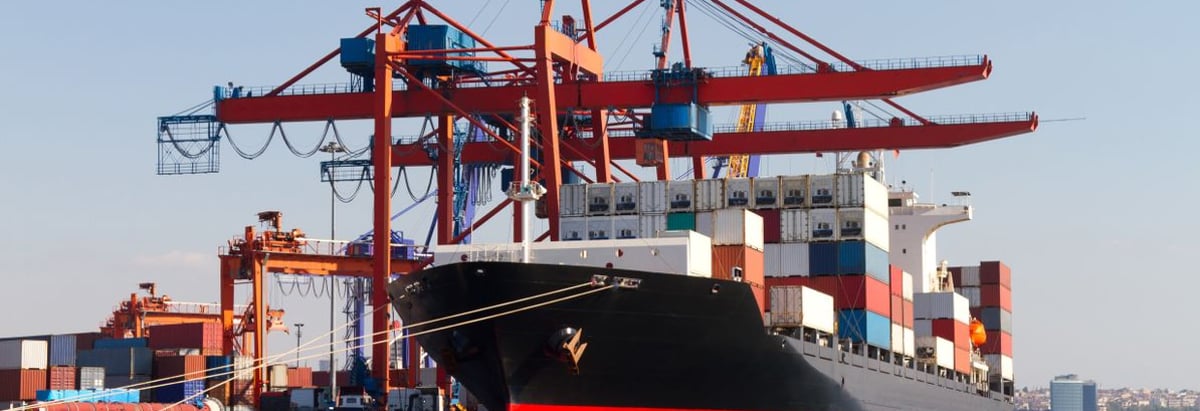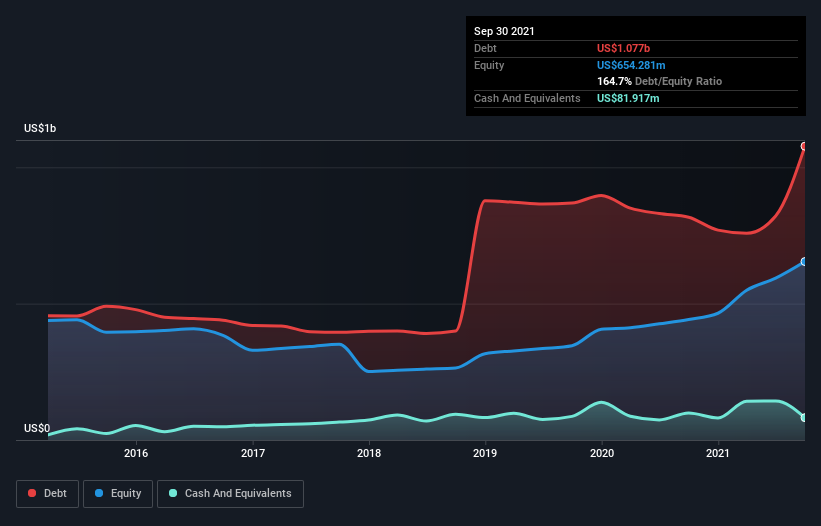Stock Analysis
- United States
- /
- Marine and Shipping
- /
- NYSE:GSL
Here's Why Global Ship Lease (NYSE:GSL) Has A Meaningful Debt Burden

Some say volatility, rather than debt, is the best way to think about risk as an investor, but Warren Buffett famously said that 'Volatility is far from synonymous with risk.' It's only natural to consider a company's balance sheet when you examine how risky it is, since debt is often involved when a business collapses. We can see that Global Ship Lease, Inc. (NYSE:GSL) does use debt in its business. But the real question is whether this debt is making the company risky.
What Risk Does Debt Bring?
Generally speaking, debt only becomes a real problem when a company can't easily pay it off, either by raising capital or with its own cash flow. Ultimately, if the company can't fulfill its legal obligations to repay debt, shareholders could walk away with nothing. However, a more usual (but still expensive) situation is where a company must dilute shareholders at a cheap share price simply to get debt under control. Having said that, the most common situation is where a company manages its debt reasonably well - and to its own advantage. When we examine debt levels, we first consider both cash and debt levels, together.
Check out our latest analysis for Global Ship Lease
How Much Debt Does Global Ship Lease Carry?
You can click the graphic below for the historical numbers, but it shows that as of September 2021 Global Ship Lease had US$1.08b of debt, an increase on US$816.8m, over one year. However, it does have US$81.9m in cash offsetting this, leading to net debt of about US$995.5m.

How Healthy Is Global Ship Lease's Balance Sheet?
According to the last reported balance sheet, Global Ship Lease had liabilities of US$195.3m due within 12 months, and liabilities of US$996.5m due beyond 12 months. Offsetting these obligations, it had cash of US$81.9m as well as receivables valued at US$4.92m due within 12 months. So it has liabilities totalling US$1.10b more than its cash and near-term receivables, combined.
Given this deficit is actually higher than the company's market capitalization of US$840.6m, we think shareholders really should watch Global Ship Lease's debt levels, like a parent watching their child ride a bike for the first time. In the scenario where the company had to clean up its balance sheet quickly, it seems likely shareholders would suffer extensive dilution.
We use two main ratios to inform us about debt levels relative to earnings. The first is net debt divided by earnings before interest, tax, depreciation, and amortization (EBITDA), while the second is how many times its earnings before interest and tax (EBIT) covers its interest expense (or its interest cover, for short). This way, we consider both the absolute quantum of the debt, as well as the interest rates paid on it.
Global Ship Lease has a rather high debt to EBITDA ratio of 5.1 which suggests a meaningful debt load. But the good news is that it boasts fairly comforting interest cover of 3.0 times, suggesting it can responsibly service its obligations. The good news is that Global Ship Lease grew its EBIT a smooth 51% over the last twelve months. Like a mother's loving embrace of a newborn that sort of growth builds resilience, putting the company in a stronger position to manage its debt. When analysing debt levels, the balance sheet is the obvious place to start. But ultimately the future profitability of the business will decide if Global Ship Lease can strengthen its balance sheet over time. So if you want to see what the professionals think, you might find this free report on analyst profit forecasts to be interesting.
But our final consideration is also important, because a company cannot pay debt with paper profits; it needs cold hard cash. So it's worth checking how much of that EBIT is backed by free cash flow. During the last three years, Global Ship Lease burned a lot of cash. While investors are no doubt expecting a reversal of that situation in due course, it clearly does mean its use of debt is more risky.
Our View
On the face of it, Global Ship Lease's level of total liabilities left us tentative about the stock, and its conversion of EBIT to free cash flow was no more enticing than the one empty restaurant on the busiest night of the year. But at least it's pretty decent at growing its EBIT; that's encouraging. We're quite clear that we consider Global Ship Lease to be really rather risky, as a result of its balance sheet health. For this reason we're pretty cautious about the stock, and we think shareholders should keep a close eye on its liquidity. The balance sheet is clearly the area to focus on when you are analysing debt. But ultimately, every company can contain risks that exist outside of the balance sheet. For example Global Ship Lease has 4 warning signs (and 3 which make us uncomfortable) we think you should know about.
If, after all that, you're more interested in a fast growing company with a rock-solid balance sheet, then check out our list of net cash growth stocks without delay.
Valuation is complex, but we're helping make it simple.
Find out whether Global Ship Lease is potentially over or undervalued by checking out our comprehensive analysis, which includes fair value estimates, risks and warnings, dividends, insider transactions and financial health.
View the Free AnalysisHave feedback on this article? Concerned about the content? Get in touch with us directly. Alternatively, email editorial-team (at) simplywallst.com.
This article by Simply Wall St is general in nature. We provide commentary based on historical data and analyst forecasts only using an unbiased methodology and our articles are not intended to be financial advice. It does not constitute a recommendation to buy or sell any stock, and does not take account of your objectives, or your financial situation. We aim to bring you long-term focused analysis driven by fundamental data. Note that our analysis may not factor in the latest price-sensitive company announcements or qualitative material. Simply Wall St has no position in any stocks mentioned.
About NYSE:GSL
Global Ship Lease
Engages in owning and chartering of containerships under fixed-rate charters to container shipping companies worldwide.
Undervalued with excellent balance sheet and pays a dividend.

